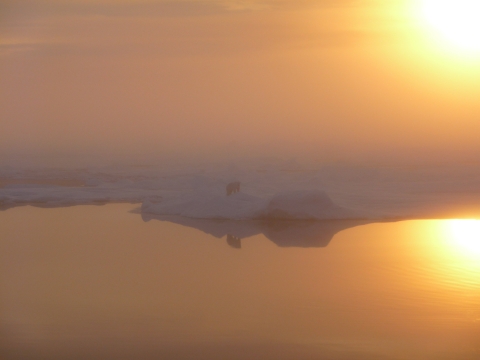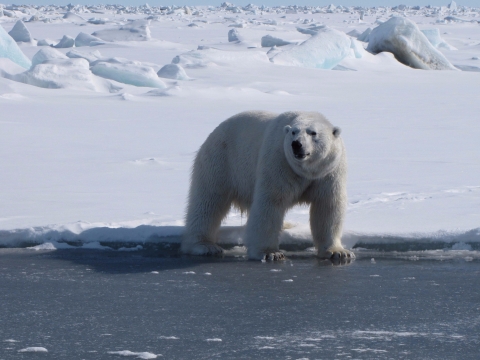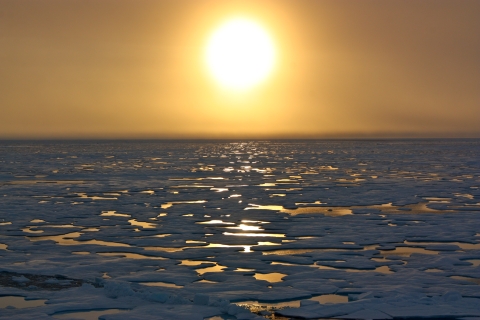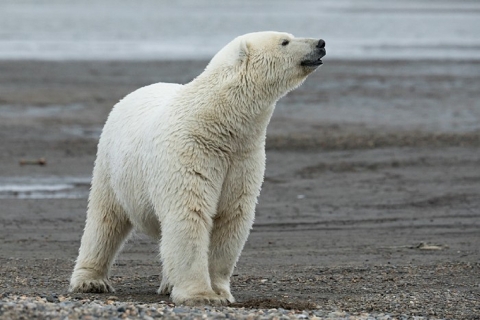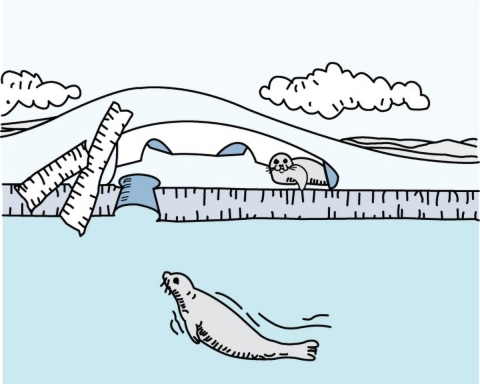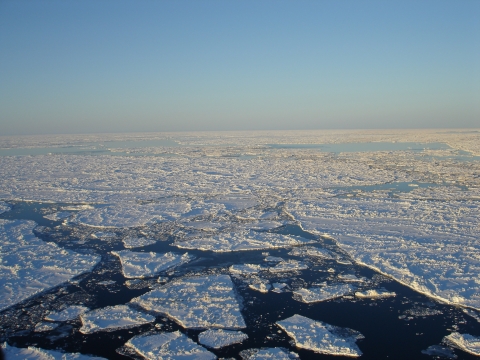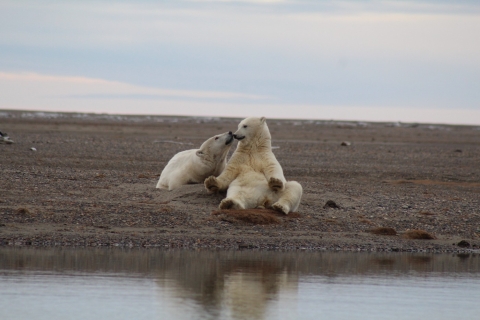The great white bears that walk the land and sea ice of northeastern Alaska and northwestern Canada make up the southern Beaufort Sea subpopulation of polar bears in the circumpolar North. Indigenous peoples have lived here for thousands of years with Nanuuq, the Inupiaq name for the polar bear; traditional knowledge holds great respect for the bear, in part for its clever adaptations to hunting and living on both sea and land and surviving in difficult conditions. The behavior and biology of the Beaufort Sea bears inspired the following story of a year in the life of a female polar bear along the coast of Arctic National Wildlife Refuge.
. . .
[The midnight sun of summer reflects off of the ice and water of the Beaufort Sea. Photo: Collection of Dr. Pablo Clemente-Colon/NOAA National Ice Center]
A mother polar bear lumbers across the snow-covered sea ice, her long snout high in the air as she sniffs this way and that. The early summer sun glows just below the icy northern horizon, even though it is nighttime. The once powdery snow is wet from melting. The bear’s gigantic feet distribute her weight evenly over the ice, their black bumpy pads gripping the slippery surface with ease.
[Polar bears have paws that are especially adapted for walking across snow and ice. Photo: USFWS.]
Several feet behind her are two cubs, nipping each other’s ears and throats as they walk. Usually, their mother would not mind their playfulness, as playtime helps them grow strong. But today, she is hungrier than ever before. She looks back at her cubs and grumbles quietly. They pause their antics and jog to catch up with her.
[Two polar bear cubs-of-the-year (born earlier that year) splash in shallow water near barrier islands of the Beaufort Sea. Photo: Susanne Miller/USFWS.]
It has been weeks since the cubs first poked their heads out of their den. It has been months since the mother had her last meal, before entering the den. If she does not find food soon, her body will stop producing the milk that her cubs need to survive.
[A polar bear walks the Beaufort Sea ice. Photo: Collection of Dr. Pablo Clemente-Colon/NOAA National Ice Center]
[Midnight sun over the Arctic Ocean. Photo: Kathryn Hansen/NASA.]
Now, they are miles from land, far out on the sea ice. The mother stops suddenly, blinking in the sun as she raises her nose. Her cubs imitate her, catching scents on the breeze. She starts walking, faster than before. After some time, she finally slows. The tiny cubs slump slump onto the ice to rest their short legs.
[A polar bear sniffs at the air, catching the scent of food. Photo: Lisa Hupp/USFWS.]
The mother sniffs again, this time pointing her nose straight ahead at a round lump in the snow. To less experienced eyes, this lump would look like nothing more than a small snow drift on the ice. The mother, however, recognizes this lump to be a seal lair.
[Illustration of a snow-covered seal birthing lair, which is entered from the water below. Credit: Robert Barnes, UNEP/GRID-Arendal]
In late spring and early summer, ringed seals give birth to pups in lairs, or ice caves, on the sea ice. They use these lairs to rest and nurse their pups. After months of fasting, mother polar bears rely on seal pups as a food source to sustain themselves and their cubs. Early summer can be a time of plenty when polar bears have the chance to gain lots of fat by hunting seal pups. This fat helps polar bears survive through summer and autumn, when the lack of sea ice makes it very difficult for them to hunt seals.
[Broken ice sheets stretch over the Beaufort Sea. Photo: Eric Regehr/USFWS.]
The mother shifts her body into a crouch as she stalks ever so slowly toward the lair. If she is discovered, the seal family will escape through a hole in their lair into the frigid waters below. Even a newborn seal pup can hold its breath and swim for minutes at a time. If the polar bear mother is to earn her first meal in months, she will need to be stealthy.
Finally, the prowling polar bear is just outside the seal lair. Her two cubs, who had been sitting quietly, are now alert and watching her every move. She gradually sits back on her haunches, preparing to pounce. The cubs, perhaps sensing that she is about to attack, leap forward as if to join her. The mother’s sensitive ears pick up the sound of seal bellies sliding across ice — they know that danger is near! She launches herself high into the air, landing on her front paws and breaking through the roof of the seal lair. She snaps her teeth!
Yet her giant paws crunch around nothing but snow and ice. She paws through the rubble, finding nothing. The seals had slipped beneath the ice into the sea. Though polar bears are strong swimmers, seals are much faster and they would be long gone by now.
[A polar bear stalking through the sea ice. Photo: USFWS.]
The cubs approach their mother, sniffing to see if she has caught anything. Realizing that she has not, they yip and growl as they scurry to her side to nurse from her belly. She turns and walks away, ignoring their hungry sounds. Again, she raises her nose to sniff the air. After a long moment, she walks energetically in a new direction. Perhaps she has caught the scent of another seal lair.
Read More! Part IV: Fall
[A mother and her yearling cub (right) touching noses. Photo: Amanda Zuelke, USFWS.]

